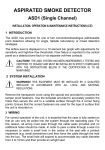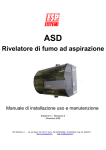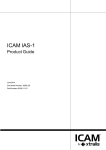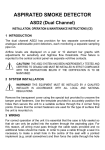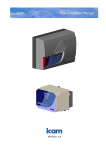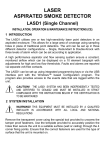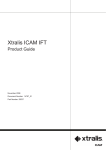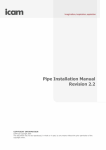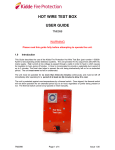Download Pipe Installation Manual ASD 1 & 2 Rev. 2
Transcript
Pipe Installation Manual ASD 1 & 2 Rev. 2 COPYRIGHT INFORMATION ICAM Ltd Copyright 2007 This document may not be reproduced, in whole or in part, by any means without the prior permission of the copyright owner. Pipe Installation Manual V2 Content 1 2 INTRODUCTION .........................................................................................................2 AIR-SAMPLING...........................................................................................................3 2.1 3 Easy access........................................................................................................................ 3 Protection of Voids, Inaccessible and High Areas...................................................................... 3 Protection of hostile environments ......................................................................................... 3 Flexibility ........................................................................................................................... 3 Invisible installations............................................................................................................ 3 GENERAL DESIGN ......................................................................................................4 3.1 3.2 3.3 4 Uses of Air-sampling ................................................................................................................3 2.1.1 2.1.2 2.1.3 2.1.4 2.1.5 System layout .........................................................................................................................4 System block diagram..............................................................................................................5 Wide-bore Systems, Units & Accessories ....................................................................................6 3.3.1 3.3.2 3.3.3 3.3.4 3.3.5 3.3.6 Detector Units .................................................................................................................... 6 Pipe Sections and Fittings..................................................................................................... 7 Brackets ............................................................................................................................ 9 Condensation Trap ............................................................................................................ 10 Heater Element with Condensation Trap ............................................................................... 10 Filter Elements.................................................................................................................. 11 Detailed Design and Installation................................................................................. 12 4.1 The Design Process .................................................................................................................12 4.1.1 4.1.2 4.1.3 4.1.4 4.1.5 4.1.6 Requirements ................................................................................................................... 12 Activities .......................................................................................................................... 12 Physical Characteristics ...................................................................................................... 12 Environmental Conditions ................................................................................................... 12 Risk Assessment ............................................................................................................... 13 Location........................................................................................................................... 13 4.3.1 4.3.2 Response Times................................................................................................................ 16 Dilution............................................................................................................................ 17 4.2 4.3 4.3 Typical layouts of ASD1 & ASD 2 ...............................................................................................14 Response Times and Dilution ....................................................................................................15 Response Times and Dilution ....................................................................................................16 4.4 4.5 4.6 Commissioning an installation ...................................................................................................18 Rules of thumb........................................................................................................................19 Design for Still Air Environments or Secondary Sampling Systems .................................................20 4.6.1 4.6.2 General Still Air Design....................................................................................................... 20 Capillary Sampling............................................................................................................. 22 4.8.1 4.8.2 Sub-floors ........................................................................................................................ 24 Ceilings............................................................................................................................ 25 4.9.1 4.9.2 4.9.3 4.9.4 4.9.5 High Areas ....................................................................................................................... 26 Prisons ............................................................................................................................ 27 Elevators – machine rooms and shafts.................................................................................. 28 Smoke domes................................................................................................................... 29 Stables & Live Stock Areas.................................................................................................. 29 4.7 4.8 4.9 Design for layouts with Air Ducts or Primary Sampling Systems ....................................................23 Design for layouts with Sub-floors and ceiling voids.....................................................................24 Unusual Applications................................................................................................................26 Part No. 09-0003-12 ASD Pipe Installation Manual 1 Copyright C 2007 1 INTRODUCTION This document is a guide for the installation of pipe-work for air-sampling systems. The pipe network is as important as the detector itself and provides a means of obtaining a reliable and continuous sample of air to be monitored. The pipe work for air-sampling systems can vary greatly depending on the particular application. This manual, therefore, gives overall guidelines that can be applied to any system but also a number of specialised set-ups are described in more detail. These include: Duct sampling High or large area buildings Prisons Staircases Stables and areas with live stock When designing a sampling pipe network one needs to achieve an air sampling network design that offers sampling hole (detector) area coverage that meets as a minimum the requirements for point type detectors. This guide is intended to give general guidelines for installing air-sampling systems but in each case, the local standards and codes of practice are to be taken into account. For reference, guidance on the design of systems is given in BS 5839, BS 6266 (Code of Practice for Fire protection for Electronic Data Processing installations, Appendix A of BS6266 gives a range of performance tests suitable for a wide variety of applications) and/or BFPSA Code of Practice for Category 1 Aspirating Detection Systems.. Aspiration system designers must be familiar with the local standards. It is strongly recommended that, before designing the pipe-work system, smoke tests be undertaken in order to show the patterns of air movement within the areas to be protected. This is particularly important in rooms with air-handling equipment. More details are given at relevant points throughout the text. Finished installations must be subjected to System Performance Tests. The various applicable tests can be found in the BFPSA Code of Practice for ASD’s. Part No. 09-0003-12 ASD Pipe Installation Manual 2 Copyright C 2007 2 AIR-SAMPLING ICAM offers wide bore air-sampling systems with both conventional and analogue addressable point detectors. Both types of system have their specific applications ranging from simple duct detection to monitoring atria and many other areas. Air sampling is the technique where air is drawn through pipes from protected areas to a central unit, where the actual smoke detector is situated. This is in contrast with traditional point detectors, where the unit is actually in the protected area. 2.1 Uses of Air-sampling Air sampling offers many benefits: Central service using pipe network. Protection of voids, inaccessible, high and hostile areas. Invisible installations using micro-bore pipes or capillary tube sampling within ceilings or below floors. 2.1.1 Easy access Only the control unit (placed at a convenient location) requires servicing. The alternative is servicing tens of point detectors, located in many different rooms. 2.1.2 Protection of Voids, Inaccessible and High Areas Air samplers are ideal for such situations. Sampling points are installed once and then require no further service. By contrast, point detectors [being located in the actual area], may be difficult or even impossible to test, service or update because of the location. 2.1.3 Protection of hostile environments Air samplers are ideal for areas with high level of dust and dirt as well where high humidity is present. Filters, heaters and water traps provide solutions in these hostile areas. 2.1.4 Flexibility Further to the advantages of sampling, the systems also benefit from all the features of the panel they are connected to like extra delays, double knock and other smart algorithms. 2.1.5 Invisible installations Often, in situations such as historical buildings, it is important to keep the installation from interfering with the décor or structure. The ASD can use on the large-bore pipes capillary tubes, which are, not only small in diameter, but are also extremely flexible. This enables pipe runs to be hidden in coving or a similarly unobtrusive place. The majority of the pipes are above the ceiling or beneath the floor and only the end of the capillary tube is visible. Part No. 09-0003-12 ASD Pipe Installation Manual 3 Copyright C 2007 3 GENERAL DESIGN 3.1 System layout The majority of aspirated smoke detection systems are used in one of two ways. The first is when there is an air handling system in the area to be protected. The second is when sampling points are used where one would normally use standard detectors, mainly in still air environments. There are also specific layouts and applications, some of which will be covered later although it is always necessary to look closely at any installation because almost every location is different. A classic system layout is shown below. This is the most basic of wide-bore set-ups. Mounting brackets Pipe(s) with sampling holes End cap with hole ASD detector Part No. 09-0003-12 ASD Pipe Installation Manual 4 Copyright C 2007 3.2 System block diagram Capillary sampling points Air intake Air sampling points Hole diameter and location along the pipes through PipeTracer software package End cap Air flow sensors monitor blockages and fractures of the individual pipes In-line filter Aspirated Smoke Detector Heater & water trap Part No. 09-0003-12 ASD Pipe Installation Manual 5 Copyright C 2007 3.3 Wide-bore Systems, Units & Accessories ASD (Aspirated Smoke Detector) air-sampling systems have one or 2 wide-bore rigid pipe outlets. It is recommended that ABS pipe is used due to its strength and heat resistant properties. These pipes can be hung under or in the ceiling of the area to be protected, in voids, shafts etc. Air is drawn in from the protected area, through a number of small holes in the sidewall of the pipes. The red pipes carrying the warning ‘ASPIRATING SMOKE DETECTION SYSTEM – DO NOT PAINT OR OBSTRUCT INLETS’ are preferred. It may in certain cases be favoured to use standard plastic conduit to avoid attention and tampering. At all times make sure the installation conforms to local regulations and is approved by local authorities. . NOTE: Pipes should be glued together to avoid separation or leaks but the pipes must not be glued into the unit itself. Removable unions should be used where maintenance may require pipes to be taken apart or removed. 3.3.1 Detector Units ASD 1 & 2 One and 2 pipe units with traditional point detectors, conventional and /or analogue addressable detectors Part No. 09-0003-12 ASD Pipe Installation Manual 6 Copyright C 2007 3.3.2 Pipe Sections and Fittings Straight pipe sections Pipes are made of ABS and come in lengths of 3 meter. Straight union Connects the pipes together. Make sure pipes and unions are always glued together. T-union Allows to T-off to one or two sections of pipes. Removable Union Use when a connection is not to be permanent. I.e. when section of pipe needs to removed for maintenance of equipment like with Air Handling Units Sticker to identify the sampling hole Part No. 09-0003-12 ASD Pipe Installation Manual 7 Copyright C 2007 End caps, (typically with a 6mm hole) Used at the end of a pipe run. Diameter of the hole determines airflow and is determined in the PipeTracer program. Bends (45º and 90º Always use slow bends as the minimise pressure loss in the system. Capillary tubes and sampling points Capillary tubes and associated sampling points allow sampling at a specific location away from the pipes. Used with i.e. with false ceilings, cabinets etc. Part No. 09-0003-12 ASD Pipe Installation Manual 8 Copyright C 2007 3.3.3 Brackets Channel Bracket Used to click on a channel. Studding Bracket Used to mount on a treaded rod. Wall Bracket Used to be fixed directly to a wall or ceiling. Closed Pipe Clip Used to be fixed directly to a wall or ceiling. Open Pipe Clip Used to be fixed directly to a wall or ceiling. Part No. 09-0003-12 ASD Pipe Installation Manual 9 Copyright C 2007 3.3.4 Condensation Trap If the air being sampled is hot and humid and there is the possibility of a temperature change causing condensation to form in the sampling pipe, a condensation trap can be used to avoid the moisture reaching the detector. As shown in the picture below, a micro-bore pipe is connected to an end cap which forms the trap. The moisture will collect in the pipe but run down and eventually out of the system prior to entering the detector. Make sure the pipe(s) are angled down towards the water trap and then onto a local drain, or water tight container that should be changed regularly. . 3.3.5 Heater Element with Condensation Trap When cold air is returned as in cold stores it is important to provide heating elements (30 W) to avoid icing of the units (see section freezers for more details). Heaters always need to be used in conjunction with water traps. Make sure the pipe(s) are angled down towards the water trap and then onto a local drain, or water tight container that should be changed regularly. Part No. 09-0003-12 ASD Pipe Installation Manual 10 Copyright C 2007 3.3.6 Filter Elements Wide bore filter The Filter, 02-FLU1, is used as a pre-filter where aspirating systems are installed to monitor excessively dusty or damp environments. Aspirating systems are ideally suited to harsh environments where conventional smoke detectors would fail to operate when subjected to water spray or excessive dust. The tubing network can be kept clean with periodic manual or automatic compressed air purges and the air sampling detector can be protected with filter+. The filter element has a large surface area to minimise the service replacement intervals. The particle sizes trapped by the element are 30 m and above as standard with other pore sizes available. Smoke particles, having a typical size of 0.01-2.5 µm, will pass through the dust filter and be detected by the laser detector. End of line sintered filter for Capillary tubes It is recommended that a sintered end of line filter is used at the end of every capillary tube. This will ensure that the airflow is not impeded by blockages such as insects. A sampling point like the one below can also be used to provide both a sturdy and safe end point and also an aesthetically pleasing one. These can be screwed to walls or ceilings and also incorporate filters. Part No. 09-0003-12 ASD Pipe Installation Manual 11 Copyright C 2007 4 Detailed Design and Installation 4.1 The Design Process When designing the actual sampling pipe network there are many factors that need to be considered. The site must be carefully surveyed and as much information as possible should be gathered. The ASD Planning and Overview Form and the ASD Design Form from the BFPSA COP come in handy at this stage. 4.1.1 Requirements It is critical to define requirements and expectations at an early stage. Consider carefully the following points: What are the end users expectations? What are the risks? What sensitivity is required from the system? What area is to be covered? What response times are required? Without concrete answers to the above there is the hazard of a badly performing system and an unsatisfied customer! Once these have been decided, the type of situation can be looked at. 4.1.2 Activities The types of activities that take place within the space are very important. A public area of a particular shape could well have different system requirements than a private place of a similar shape. Some different examples are outlined below. Other information such as the expected hours of operation, whether the area is manned or unmanned and whether any pollution or dirty air is present should also be taken into account. 4.1.3 Physical Characteristics Once the general installation type has been considered, the physical characteristics of the space are looked at and the following questions should be asked. Is it a room, void, cabinet or enclosure? Are there any floor or ceiling voids and, if so, how are they divided, are there any ducts, what are these used for and are there any services already present? What are the exact measurements of the space? What materials have been used and are there any areas where the network has to avoid? Are there any existing fire protection systems and where are they situated? Does the fire load change regularly? 4.1.4 Environmental Conditions The environment within the space can have a very significant bearing on which sampling method should be used to protect it. As already mentioned, the smoke tests are vital in gathering this information. This can tell you the patterns of air movement, the rate of circulation and whether the airflow is static at any point. Other considerations include: If fresh air is introduced, at what rate and in what quantity? What is the temperature and relative humidity and are these constant or variable? Are there any activities that may produce smoke, dust, steam or flames and how often does this occur? Part No. 09-0003-12 ASD Pipe Installation Manual 12 Copyright C 2007 4.1.5 Risk Assessment With any installation it is likely that some areas require more protection than others. This could be because of expensive equipment or a particularly vulnerable area such as a store for flammable materials. These more susceptible areas must be considered along with any structural hazards such as synthetic materials and foams or soft wood partitioning. 4.1.6 Location There are also factors to consider when deciding on the position at which the detector itself will be situated. The main aim when positioning the detector unit is to try to ensure a balanced system. This means that the pipes should be kept at similar lengths. It is also important to try and keep response times and dilution to a minimum. These are two very important factors in air-sampling and are discussed in more detail in the following section. The unit requires a power supply and access will be required for maintenance. There may also be aesthetic reasons why a particular position is not suitable. Part No. 09-0003-12 ASD Pipe Installation Manual 13 Copyright C 2007 4.2 Typical layouts of ASD1 & ASD 2 The following layouts, pipe lengths and number of holes are according the VdS test results and approvals Using ASD1 in the type 1 layout pipe run can go up to 50 m The amount of holes in the pipe is depending on the detector that is used. See below for details. APOLLO DETECTOMAT GE SECURITY HOCHIKI SYSTEM SENSOR Part No. 09-0003-12 S65 Optical XP95 Optical DISCOVERY Optical CT 3000 D PL 3200 O PL 3300 O DP 721I DP 2061 DP 951 SLR-E3 ALG-E 2251EM - standard 2251EM - high ECO 1003 1 2 1 1 1 1 3 6 2 1 1 1 2 2 x x x x x x x x x x x x x x 8mm End Hole 8mm End Hole 8mm End Hole 8mm End Hole 8mm End Hole 8mm End Hole 4mm Holes 4mm Holes 8mm End Hole 8mm End Hole 8mm End Hole 8mm End Hole 5mm Holes 5mm Holes ASD Pipe Installation Manual 14 Copyright C 2007 When using ASD2 in the type 1 layout both pipe runs can go up to 50 m The amount of holes in the pipe is depending on the detector that is used. See below for details. APOLLO DETECTOMAT GE SECURITY HOCHIKI SYSTEM SENSOR S65 Optical XP95 Optical DISCOVERY Optical CT 3000 D PL 3200 O PL 3300 O DP 721I DP 2061 DP 951 SLR-E3 ALG-E 2251EM - standard 2251EM - high ECO 1003 1 2 1 1 1 1 3 6 2 1 1 1 2 2 Pipe 1 x 8mm End Hole x 8mm End Hole x 8mm End Hole x 8mm End Hole x 8mm End Hole x 8mm End Hole x 4mm Holes x 4mm Holes x 8mm End Hole x 8mm End Hole x 8mm End Hole x 8mm End Hole x 5mm Holes x 5mm Holes 1 2 1 1 1 1 3 6 2 1 1 1 2 2 Pipe 2 x 8mm End Hole x 8mm End Hole x 8mm End Hole x 8mm End Hole x 8mm End Hole x 8mm End Hole x 4mm Holes x 4mm Holes x 8mm End Hole x 8mm End Hole x 8mm End Hole x 8mm End Hole x 5mm Holes x 5mm Holes Please also make sure you use the correct baffles. Baffles are plastic inserts that help to maximise the aspirated air flow trough the detectors. 4.3 Part No. 09-0003-12 ASD Pipe Installation Manual 15 Copyright C 2007 Response Times and Dilution Dilution and response times are two factors that can cause the system to under-perform. 4.3.1 Response Times The transport time of a system is the time taken for a smoke particle to travel from the sampling point to the detector. The response time is the transport time plus any delays set in the detector. In any situation where an air-sampling system is being used, early detection is vital and therefore response times are kept to a minimum. The simplest method of achieving this is to keep pipe lengths to a minimum. Example: The advantage of multiple sampling pipes. This room has a single sampling pipe that provides detection for the whole room. The same room with two sampling pipes: Part No. 09-0003-12 ASD Pipe Installation Manual 16 Copyright C 2007 4.3.2 Dilution As the name suggests, dilution is the process of lessening the concentration of smoke particles as the sample is sucked towards the detector. For example: There is a sampling pipe measuring 30 meters. It has sampling holes every 10 meters, giving 4 sampling holes including the end cap. It can be assumed in this simplified case that the sampling holes let in approximately the same amount of air as each other. A smoke source of 4% obscuration/meter is introduced at the far end of the pipe. No other smoke is entering any of the other sampling holes. As the smoke passes each hole, it is added to with clean air. When the sample reaches the detector it is now at 1% obscuration/meter or 1/4th of its starting density. Therefore if the detector alarms at 1% obsc/m, the smoke outside the hole must exceed 4% obsc/m to sound the alarm. It is the case, therefore, that the longer the pipe and the greater the number of sampling holes, the more susceptible the system will be to dilution. It is wise to work on a worst case principle in these situations. Actuality the calculation of dilution is not as straightforward as above and more factors are involved. Each system will have different characteristics meaning precise calculation is extremely complicated. Lower density to detector Smoke in high density Clean Air Part No. 09-0003-12 ASD Pipe Installation Manual 17 Copyright C 2007 4.4 Commissioning an installation It is necessary to carry out an inspection of the completed installation to check for quality of workmanship, correct use of materials and that the installation fully complies with the correct National Standard that the intended ASD systems have been installed to. After the wide bore pipe network has been installed, before the end cap is put on and before the pipes are attached to the unit it is necessary to clean the internal pipe system to remove unwanted swarf debris and dust which could affect the ASD system performance. This may be done by either a positive blowing-out of the pipe network with compressed air or by the use of a vacuum cleaner. Commissioning tests should be carried out depending on the ASD system application and only when the building is in its normal, intended running state. Appropriate commissioning tests should also be performed after modifications and/or additions to the ASD system. BFPSA COP presents a performance test according to the response of a Class C system Always provide for an easy access test hole at the furthest end of all pipe runs! Easy access test point Part No. 09-0003-12 ASD Pipe Installation Manual 18 Copyright C 2007 4.5 Rules of thumb When designing aspiration systems it is good workmanship to observe the rules of thumb listed below • • • • • • • • • Spacing requirements not to exceed point detector spacing. Joints shall be permanently bonded. If the sensor is mounted outside the protected area, return the exhaust back to the protected area. Do not run pipes in areas with different air pressure ABS or PVC Pipe to comply with local quality standards. Power supply to comply with local requirements Length of pipe: shorter pipe length shorter response times. Share per hole: shorter pipes = better hole share, i.e. the difference between the flows into the first and last sampling points are reduced as the pipe gets shorter. Number of Bends: less bends less travel time and better flow. In general Only smoke tests will show exact smoke path, helping the designer to correctly locate pipes and sampling holes Part No. 09-0003-12 ASD Pipe Installation Manual 19 Copyright C 2007 4.6 Design for Still Air Environments or Secondary Sampling Systems 4.6.1 General Still Air Design Still air environments do not have a pattern for the air movement. This means that the sampling points must give general cover across the whole expanse of the area. The coverage and layout will closely follow the guidelines for traditional point detectors. Failure to design and install a properly thought out pipe network can result in slow response times thereby negating some of the early warning ability of the system. The way to avoid any problems occurring is to ensure that all pipes are a similar, or preferably equal, length. Typical examples: Prisons, atria, ducts, elevator shafts, escalators, display cabinets, stables and residences. Design Criterion: Design to BS EN 54 (BS 5839 Pt.1) that states that no point in the room should be further away from a detector than 7.5 meters. Each traditional detector should cover an area no greater than 100 square meters. Keep the pipe lengths as similar as possible to ensure a balanced system and minimal response times. Distance A: maximum 5 m Distance B: maximum 10 m Part No. 09-0003-12 ASD Pipe Installation Manual 20 Copyright C 2007 This layout is showing point detectors in a simple 400 square meter building Layouts showing a sampling system in a simple 400 square meter building. A pipe covers the same area. The red dots show the position of the sampling holes which are identical to the position of the point detectors above. The width of the pipes and the detector in the picture are enlarged in order to make them clearly visible. Always use a grid overlay to determine the correct positioning of the pipe network and ensuring full area covering. Wrong positioning as not all of the area is covered Correct positioning as all of the area is covered Part No. 09-0003-12 ASD Pipe Installation Manual 21 Copyright C 2007 4.6.2 Capillary Sampling Short lengths of small diameter flexible pipe may be spurred off from the main wide-bore pipe. These capillaries should have an internal diameter of no less than 7mm and can be up to 1,5 meters length. To create the sampling point, a sampling point assembly should be used. Capillary Sampling is particularly useful for concealed sampling points For aesthetic reasons, the sampling points may need to be as unobtrusive as possible. Often the main wide-bore pipe runs through a ceiling void, with capillary sample pipes taken off through the ceiling. The sampling holes are made using a sampling point assembly. This is a simple assembly into which the capillary tube fits. If small insects or dirt is expected a sintered end of line filter can be mounted to the sampling point itself. Capillary tubes Ceiling panel or tile Concealed Sampling point fitting Part No. 09-0003-12 Sampling point fitting ASD Pipe Installation Manual 22 Copyright C 2007 4.7 Design for layouts with Air Ducts or Primary Sampling Systems Return Air, Exhaust Air and other Air Conditioning Ducts are typically regions of very high airflow. Providing Aspirated Air Sampling Detection Systems in these areas can be very beneficial. Large areas can be protected with relatively few detectors and also with minimal intrusion into the protected area thereby reducing the costs of installation and maintenance involved. This method is also unobtrusive which can be an important factor in deciding the type of installation for architects and end users. Normally Aspirated Air Sampling Systems would be placed in air return ducts as supply air ducts can be filtered or be contaminated with makeup air possibly making the system ineffectual and the cause of nuisance alarms. If the ventilation system does not operate permanently it may be necessary to install a secondary system to sample within the protected area during the times that the Air Conditioning plant is shut down. In some countries this is mandatory. The intake pipe should span approximately the entire duct width. If the duct is very wide then, to increase rigidity, the pipe may be supported at intervals across the duct.. For small ducts up to 1m across sampling holes at 100 to 150mm intervals. For larger ducts sampling at intervals of 200 – 250mm is appropriate, It may also be necessary to run the sampling pipe at more than 1 level through the duct especially when the sampling is located close to bends in the ductwork. The holes should face 20 to 45 degrees above or below the centre line of the airflow stream to so at avoid the pressure curve that forms around the pipe as the airflow passes around it. The first and last hole are normally located about 100 mm from the edges of the duct to be into the laminar flow area of the duct. Also have the same number of holes on the inlet pipe AND the outlet pipe. Doing so, if the airflow changes in the duct, the pressure across the detector can be maintained and therefore a flow fault will not occur. Flow faults will only annunciate when the flow through the detector fails, i.e. failed air pump or blocked holes. The end of the pipes should be extended through the side of the duct and have end caps fitted. The holes through which the pipes are positioned must be kept airtight. The intake should be offset from the exhaust pipe to avoid turbulence, with at least 300mm (distance A) separating the two as well as being at least 50mm different in height . The material of the sampling pipes should be suitable for the application i.e. verify if the duct is carrying extremely hot air or gasses that are not suitable for the standard plastic in which case copper of steel conduit may be used. Ensure that an extended pipe run is made outside the duct to allow the sampled air to cool. If the air inside the duct is hot and/or humid, problems will occur if the temperature changes and cause condensation within the cooler sampling pipe outside the ductwork. If this is the case, use a condensation trap before the sampling pipe enters the detector to stop the ingress of moisture into the detector. Ensure that the intake pipe is dropped lower than the detector to house the water trap. This further ensures that overflow moisture cannot enter the detector. Pressure curve Part No. 09-0003-12 ASD Pipe Installation Manual 23 Copyright C 2007 4.8 Design for layouts with Sub-floors and ceiling voids 4.8.1 Sub-floors In some cases it is advisable to monitor a sub floor area even if it is not part of the main air-conditioning system. A typical example will be if they contain power or data cables as shown in the picture below. Pipe work to BS6266 1992 for primary detection Preferred sub-floor fixing of pipes Part No. 09-0003-12 ASD Pipe Installation Manual 24 Copyright C 2007 4.8.2 Ceilings In some cases it is advisable to monitor a ceiling void, even if it is not part of the main air-conditioning system. A typical example will be if they contain power or data cables as shown in the picture below. Pipe work to BS6266 1992 for primary detection Part No. 09-0003-12 ASD Pipe Installation Manual 25 Copyright C 2007 4.9 Unusual Applications Due to the fact that most installations take place in different environments, the guidelines above are fairly flexible. The exceptions come when exceptional environments are involved. If the area is essentially a room, with or without AHUs, then the rules are straightforward and vary little from place to place. Unusual applications are those which deviate in some way that changes the way the air movements may behave. These include high areas, voids, restricted areas or those which have safety considerations and places where samples may be contaminated with dust. In these different and variable situations, it is vital to perform smoke tests to establish the air movements. 4.9.1 High Areas Typical examples: Atria. When designing a system to fit in a very large and high room such as an atrium or high level warehouse, it is very important to consider the various possibilities. A simple atrium design is shown below, utilising two vertical pipes. The smoke cloud is shown as an example of how a stratification layer prevents the pipes at the top of the building being effective. The height at which the smoke forms a layer varies depending on temperature and therefore a vertical sampling pipe is used to cover this. There may be no stratification layer at all if the air in the room is at a particular temperature. A detection point at and the level of the smoke extraction dome and having the detector a man height is the safest and most maintenance friendly solution for these domes. Smoke stratification layer at thermal equilibrium Part No. 09-0003-12 ASD detector Sampling pipes ASD Pipe Installation Manual 26 Copyright C 2007 4.9.2 Prisons The ultimate advantage of air sampling in prisons is the inmate incapacity of vandalism and tampering. The air from the protected area is actively sampled through a network of pipes. These pipes typically have one sample hole per cell. The sampling pipe and air sampling hole(s) are concealed inside the cell often in light fittings or inconspicuously in the HVAC system. Typically the sampling hole is installed in the return air grille. Alternatively, flush capillary Sampling Points can be used, concealed in the cell. The ASD unit itself can be protected by a metal case or is more normally sited in the service riser between to adjacent cell. The ASD provides closed loop sampling whereby the exhausted air can be completely returned to the sampled prison cell. ASD lends itself ideally to the latest style prefabricated cells where the total install can be made off site. Part No. 09-0003-12 ASD Pipe Installation Manual 27 Copyright C 2007 4.9.3 Elevators – machine rooms and shafts A 25 mm ABS pipe is installed along the elevator shaft and in the machine room. In the pipe(s) at regular distances, +/- 10 m from each other, 2-3 mm size holes are drilled. The pipe is connected to the aspiration detector. The air from the protected areas is drawn, by a powerful aspirator fan, to the detector through a network of pipes into the smoke detection chamber. The sampled air is drawn through a series of filters. A coarse (20 ppi) and a fine filter (45 ppi) are built in to the detector. Inside the chamber, one or two smoke detectors analyse the air. The smoke detectors are traditional, standard sensitivity point detectors. In case a higher sensitivity is required one can use laser detectors. The detectors can be connected to an existing fire control panel or can operate independently and provide alarm information, via a relay output, for local action. Equally they can connect to a transmission unit to alert a 24/7 manned control station. The aspiration detector is placed outside the machine room and shafts. As such the detectors are always accessible for test and maintenance without the need to enter the prohibited elevator areas. In those areas with excessive dust and dirt a Filter+ can be used as pre-filter. The filter element has a large surface area to minimise the service replacement intervals. The particle sizes trapped by the element are 30 m and above as standard with other pore sizes available. If the air being sampled is hot and humid and there is the possibility of a temperature change causing condensation to form in the sampling pipe, a condensation or water trap should be used to avoid the moisture reaching the detector. When cold air is returned as in cold stores and freezers it is important to provide heating elements (30 W-230Vac) to avoid icing of the units. Part No. 09-0003-12 ASD Pipe Installation Manual 28 Copyright C 2007 4.9.4 Smoke domes Aspiration sensors are also a preferred detection method for smoke extraction domes. The detection areas are difficult to access and as stratification can occur it is preferred to sample also along the shaft. 4.9.5 Stables & Live Stock Areas Humidity, corrosion, dust from hay & straw and effluent prevent traditional point type smoke detectors from providing an efficient false alarm free environment. Air Sampling systems provide not only efficient false alarm free environment but also the sensitivity that is required to provide the evacuation time needed in these environments The other major advantage of air sampling systems is that of maintenance. Due to the simple pipe work arrangements the detector can be located in a position that is easily accessible, serviceable and visible. Part No. 09-0003-12 ASD Pipe Installation Manual 29 Copyright C 2007






























